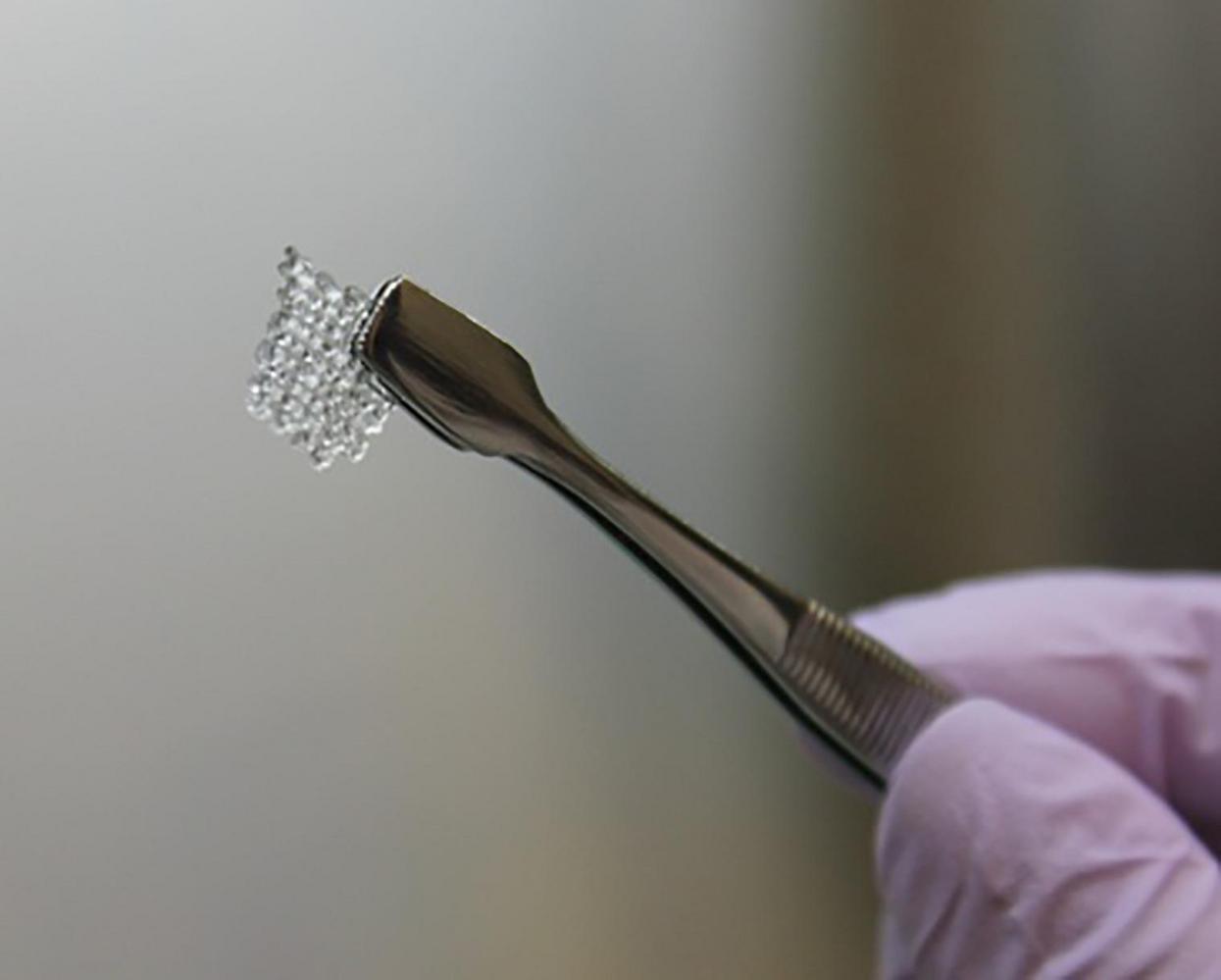The Future of Additive Manufacturing for Regenerative Medicine
Dimension Inx’s novel approach could break the mold in the field of bioprinting human tissue.
Over the past few decades, additive manufacturing has garnered significant research attention. Its application prospects in the field of medicine, in particular, are quite promising. Each individual’s anatomy functions differently: the better the fit, the better the patient outcome. In the health care sector, additive manufacturing has been used to create 3D models for surgical planning, bespoke implants, orthodontic aligners and drilling guides, which can help decrease procedure time, reduce medical errors, and provide practitioners with additional information before they even step into the operating theatre. These macroscopic applications beg the question—can this technology be used to influence the body on the microscopic scale?
Dimension Inx, an Illinois-based regenerative medicine company, is tackling this challenge head-on. The organization primarily focuses on developing therapeutic solutions for restoring tissue and organ function. It is currently deep into its research on the benefits of using 3D printing to create microenvironments that can direct cells to engage in certain behavior. This can, in turn, accelerate the healing process.
Dimension Inx’s goal is to use 3D printing to replace dysfunctional tissue with healthy, patient-specific tissue, which can facilitate the repair and regeneration of human organs. This has enormous implications for worldwide health care outcomes: 3D printing, in combination with the use of stem cells, can significantly reduce mortality in patients who are waiting for suitable organ donors. Further, it can reduce health care costs by approximately $1 trillion annually in the United States alone. In combination, these two factors could have immense repercussions on the global medical sector.
The Underlying Principles of Bioprinting
There are three ingredients necessary to begin “engineering” biology, so to speak: the cells themselves, the extracellular matrix and cues. In short, the matrix forms the “skeleton” around the cells, and the cues form the basis for the interactions between the cells and the matrix, profoundly affecting the former’s proliferation.
However, most research and funding focuses on optimizing and improving the cells themselves. There is a profound dearth of research on the cues (or microenvironments of the cells), which act as the blueprint for cell action. This is particularly of concern because cells can’t simply be injected into the body and expected to perform their tasks effectively. Although integral to the process, the cells alone cannot regenerate damaged tissue and restore function. Particular combinations of these cells and cues need to be engineered to achieve the desired results.
Dimension Inx’s Advanced Technology
Enter Dimension Inx, an industry disruptor that uses a contrarian and novel approach to bioprinting. As the company puts it, its focus is on providing cells with a “happy place,” which refers to a microenvironment that facilitates cell proliferation. This is accomplished by putting into practice what we already know about cellular biology and applying it to 3D printing. It’s important to note that slight differences in a given microenvironment can have profound implications on patient outcomes. The customizability of 3D printing can be a real advantage in this field: printing certain templates for these microenvironments can be used to promote the desired cell behavior, including cell differentiation, blood vessel formation, or collagen deposition.
There’s one major issue here, though. There is always a trade-off between conventional 3D printing equipment and traditional biomaterials. It’s very common for the processes used to require the modification of certain biomaterials. For example, if collagen will be used, some amount of synthetic polymethylmethacrylate (PMMA) may need to be added to the mixture to increase its strength. This significantly affects the biofunctionality and biocompatibility of the printed component.
To mitigate this issue, Dimension Inx uses advanced technology to ensure that the biomaterials printed rely on microenvironments and signaling instead of chemical modification, which means that there is no compromise in the product’s biofunctionality. The basis of this technology is a rapid, room-temperature additive manufacturing process used to produce regenerative structures that can address complex issues.
This bottom-up approach functions by directly extruding 3D “paints,” which dry instantaneously and do not require post-processing (such as sintering or heat treatment). The advantage of these 3D paints is that different types of paints can be combined to create gradient paints. For example, the paint used for bone tissue can be combined with paint used for cartilaginous tissue, creating a “hybrid” variant. Dimension Inx has created several proprietary 3D paints, such as Hyperelastic Bone, which contains 90 percent calcium phosphate by weight, making it highly biofunctional.
A good example of the company’s work lies in a collaboration with Northwestern University and the Ann & Robert H. Lurie Children’s Hospital of Chicago, which demonstrated one of the first implanted organs created via additive manufacturing: a bioprosthetic ovary in rats.

A scientist holding a 3D-printed mouse ovary cell scaffold. (Image courtesy of Northwestern University.)
The team 3D printed a scaffold with a microstructure that provided the optimum conditions for the growth and maturation of reproductive cells. This ovary was implanted into a rat, which led to multiple generations of pups, clearly demonstrating its feasibility.

A litter of green pups born from the bioprosthetic ovary. (Image courtesy of Northwestern University.)
Adoption of the Technology
There is often hesitance when it comes to the adoption of new technologies, but it’s crucial to develop novel workflows to ensure the smooth implementation of Dimension Inx’s technology. Since the stakes are quite high in this field, quality assurance is crucial for its widespread implementation.
However, this is not at all a trivial matter for massive hospital systems. Dimension Inx is currently working to implement such a system itself, while RICOH 3D and IBM Medical are also working on their own solution for large-scale hospital systems. This can allow a large number of clinicians to have access to 3D-printed models and hasten the adoption of this technology in hospitals. Further, in light of these developments, the U.S. Food and Drug Administration (FDA) has provided guidelines for the 3D printing of medical devices at the point of care. The future looks promising.
Several companies are currently making strides in the additive manufacturing of human tissue. One U.S.-based company is Organovo, which uses proprietary technology to bioprint living tissue. Another company called Cyfuse, based out of Japan, has developed its own bioprinter called Regenova. An Indian company, Next Big Innovation Labs, is also focused on bioprinting complete organs for use in developing countries. This international interest will work to hasten the implementation of this technology and provide an impetus for its development.
How Can the 3D Printing Community Be a Part of This?
Recently, 3D Systems announced that it plans to focus on two high-growth areas, one of which is the medical sector. This is a direct consequence of the fact that investors and companies alike are increasingly recognizing the positive trajectory of additive manufacturing in the field of health care. According to PitchBook data, over the last two years, more than $1 billion has been invested in this sector, in over 50 companies.
However, data seems to indicate that this industry is at an inflection point. A lot of work needs to be done now to ensure that both the public and industry stakeholders remain convinced that this technology can be scaled sufficiently to provide widespread health care solutions. From this perspective, there are a few actionable steps the community can take.
First, individuals in the medical space can work on improving access to this technology at the point of care. This includes promoting the use of additively manufactured surgical guides, implants and models. This will undoubtedly raise investor interest in the sector, which forms the basis for increased adoption.
Second, at this stage, it’s crucial to pressure regulatory bodies to provide incentives, propose reimbursement schemes, and set quality standards for this specific technology. In particular, the FDA needs to provide increased guidance regarding the point-of-care manufacturing of 3D-printed parts. To accomplish this and gain increased clarity, individuals should contact the FDA to indicate that there is sufficient interest in such programs.
Third, and probably most important, more products in this space need to be commercialized. A larger number of products need to be readily available to the public. This rollout is currently in its nascency. Therefore, it’s important that people in the 3D printing community begin to engage with investors and policymakers through multiple avenues. Examples of groups that can be directly contacted are the Advanced Regenerative Manufacturing Institute (ARMI) BiofabUSA, the U.S. Department of Veterans Affairs, and the Radiological Society of North America.
Dimension Inx can help provide custom solutions for therapeutics—whose progress can have a profound impact on our future and that of our progeny.








